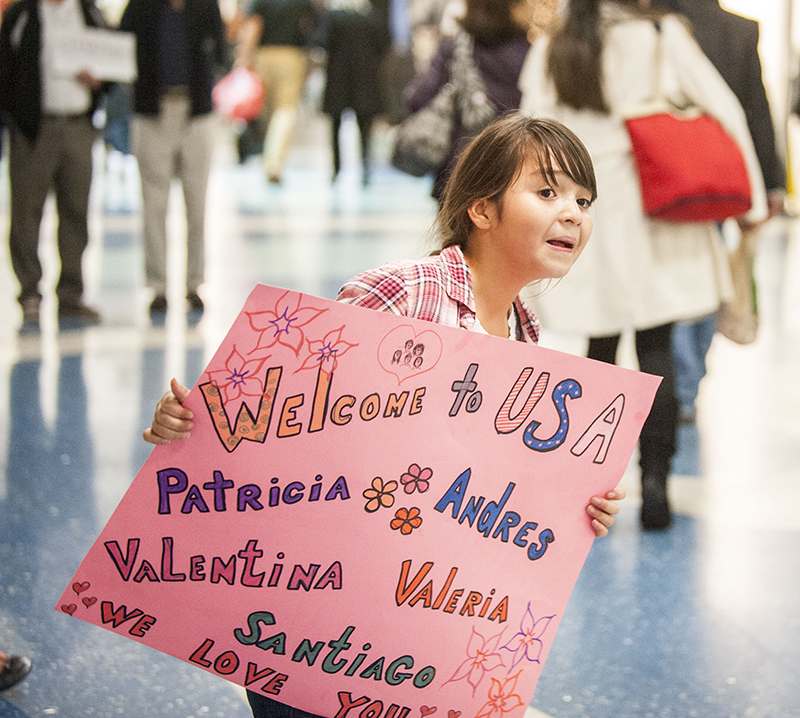By Sarah Williamson | gargoyle@flagler.edu
Photos by Sarah Williamson
The airport environment has always been a thrill: people coming and going, mixed languages, smells, busy-ness and along with it, the mystery of unknown destinations.
It is Tuesday, Nov. 12, 2012, as I arrive at the Jacksonville International Airport.
I had walked through this long corridor many times before; the lights have the same brightness, fixated on the swarms of moving bodies. Yet, something is different on this evening. I have no bags in hand, just a camera and three lenses.
I am about to capture a family reuniting. Not your typical affair, this family — the Rincons — are refugees. Recently displaced from Colombia and living in Ecuador, the family of five is the third group in the Rincon family to arrive in America. The matriarch, Florinda Leaf de Rincon, will see children and grandchildren together for the first time since 2010.
Before the airport, I met Michelle Karolak at the Catholic Charities office in Jacksonville. She shuffled quickly around her desk, checking off a list in her mind: family tree … check, flowers … check, chocolate … check. She offers me a Reese’s. I am curious if she can sense my nerves.
Karolak has devoted her life to many humanitarian projects. She has been a part of the Peace Corps and spent years in Africa working on AIDS projects. She settled in Jacksonville with her husband and found her mission working for the refugee resettlement program at Catholic Charities.
Catholic Charities resettles thousands of refugees a year. Karolak tells me that tonight is the 37th arrival in the last two months.
I ask her about the Rincon family. Why are they refugees?
She opens a brown cabinet full of files — husbands, wives, sons and daughters all waiting to be accepted into the United States.
“Some have been waiting for years,” she says, shutting the drawer.
She says the Rincon family has been arriving swiftly since August and that this is a unique case. I wonder silently why some families make it to the top of the list while others are left waiting in a brown filing cabinet.
…………………………………….
It is 6:31 p.m.
Karolak and I spot the eldest Rincon and her grandchildren. They are standing by the arrival gate. The oldest of the five hold American flags; the youngest grasp two hand-made welcome signs.
Rincon smiles as we approach and Karolak explains to her that I will be taking photos. She understands little English, but does not mind as I circle her family, clicking the shutter discreetly, while trying to catch the glow of excitement in their eyes.
The youngest children are most anxious. They dance around as the clock ticks, jumping up and down with their colorful signs. Busy travelers, while absorbed in their own agendas, cannot help but smile.
Rincon does not relay much expression. In the hour that we wait, she rarely looks away from the arrival gate.
Peggy Lawrence also lingers with the family. She is a new volunteer for Catholic Charities and has helped resettle the Rincon family since their first arrival in August.
I took a break from snapping photos. Lawrence shares with me what little background she knows: a family member was killed, the youngest girl has a mother that remains in Colombia and there are a lot of politics involved.
“We don’t ask,” Karolak told me in the car on the way to the airport. “Over time, people start sharing their stories.”
…………………………………….
After almost an hour of anticipation, the arriving family appears in the distance. Their smiles are wide. All signs of exhaustion from a day’s travel dissolves from their faces.
The youngest run toward the security line and the others follow close behind.
It all happens so quickly: the hugs — signs and flags now squished between each other — kisses, laughter and tears.
Two of the boys leave their huddled family and scurry into the distance. He hands his cousin, who has just arrived, an American flag. He holds it high. Maybe he is sharing with his cousin what he thinks of America so far. Maybe he is telling him about school. Maybe he is telling him how much he has missed him the last two years.
…………………………………….
After the luggage is gathered, I follow the newest Rincon family, volunteers and Catholic Charities workers to their home.
We arrive. The children once again scurry off to show their cousins the bedrooms, while the parents stand in awe at their new, two-bedroom apartment.
What happened to their other home? Where is the rest of the Rincon family? Are they safe?
I realize, driving home hours later, that for the first time I was actively involved in the true magic of an airport: a family, past unknown, reuniting for the first time in years.
What kept them apart?
I never had that question answered.
How did it feel to be reunited?
This was answered through my photos.
“Even though they look like they’re OK and they have support, anything can happen. We don’t know what they’ve been through,” Karolak said in the car.
I left not knowing the atrocities the Rincon family could have witnessed in Colombia. But this story isn’t about where they have been. It is about where they are now — and that is finally together again.




Be the first to comment on "Together again: Colombian refugees resettle in Jacksonville"